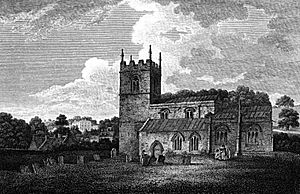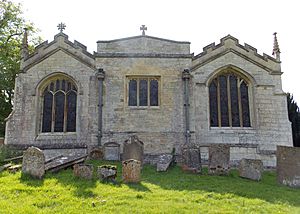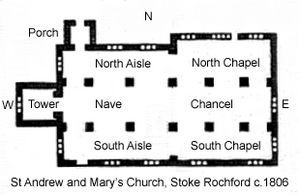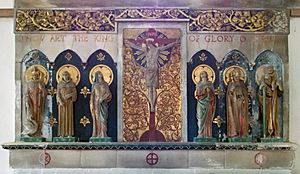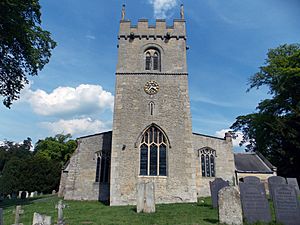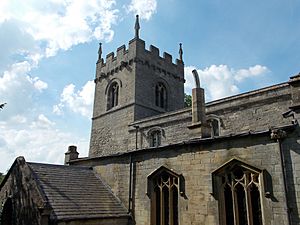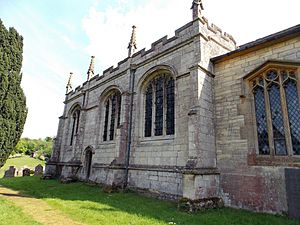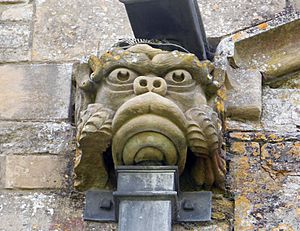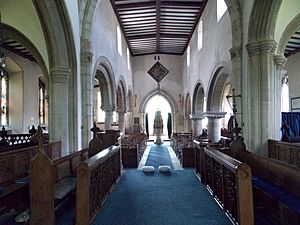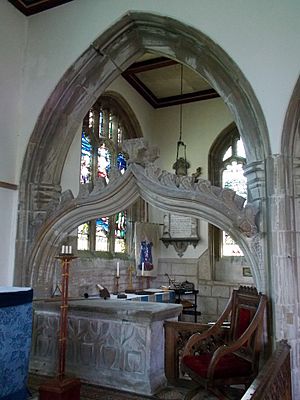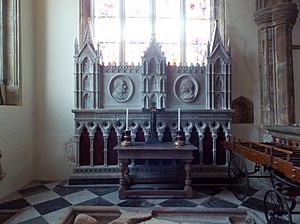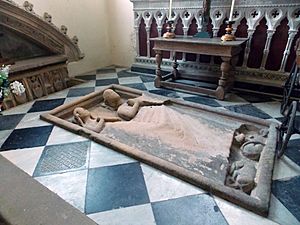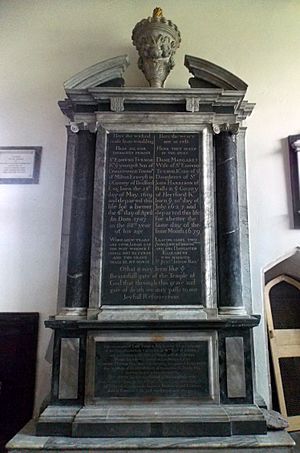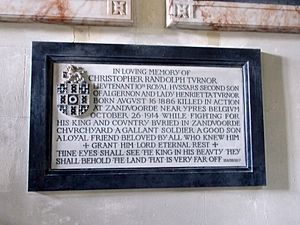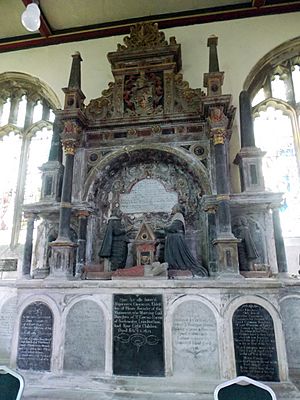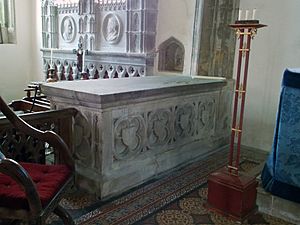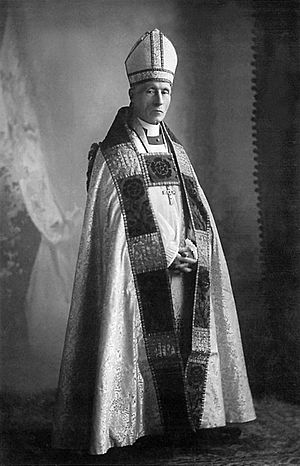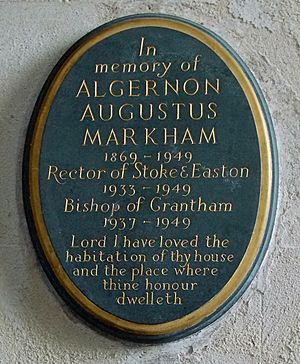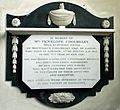St Andrew and St Mary's Church, Stoke Rochford facts for kids
Quick facts for kids St Andrew and Mary’s Church, Stoke Rochford |
|
|---|---|
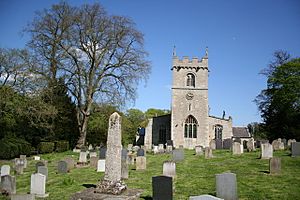
St Andrew and St Mary's church, Stoke Rochford
|
|
| 52°50′09″N 0°38′06″W / 52.835803°N 0.63498205°W | |
| Country | England |
| Denomination | Church of England |
| Previous denomination | Roman Catholic |
| History | |
| Founded | 11th century |
| Dedication | Saint Andrew; Saint Mary |
| Architecture | |
| Heritage designation | Grade I |
| Designated | 20 September 1966 |
| Architectural type | Norman; Perpendicular |
| Specifications | |
| Materials | Ashlar and limestone rubble |
| Administration | |
| Parish | Stoke Rochford with Easton |
| Deanery | Deanery of Beltisloe |
| Diocese | Diocese of Lincoln |
| Province | Canterbury |
St Andrew and St Mary's Church is a very old Church of England parish church located in the village of Stoke Rochford, Lincolnshire, England. It is dedicated to Saint Andrew and Saint Mary. The church is about 5 miles (8 km) south of Grantham. It is considered a very important building and has a special "Grade I listed" status, meaning it's protected for its historical and architectural value.
This church is well-known because of its connections to the powerful Cholmeley family from Easton Hall and the Turnor family from Stoke Rochford Hall. Many memorials inside the church honor these families. St Andrew and St Mary's is part of a group of churches in the area, including those in Colsterworth, Skillington, Great Ponton, and Little Ponton.
Contents
A Look Back: The Church's History
The church's official records, called the parish register, began in 1663.
Early Beginnings
Records from the 1086 Domesday Book mention settlements near where the church stands today. At that time, there wasn't a complete church or a priest. However, parts of the church suggest it might have started as early as the 11th century. By the late 1100s, there were two churches: St Andrew's in North Stoke and St Mary's in South Stoke.
Over time, the village of Ganthorpe, which had its own chapel, disappeared. North Stoke village was also taken down between 1841 and 1843 to make way for the expansion of the Stoke Rochford Hall estate.
On June 13, 1776, the two churches, St Andrew's and St Mary's, officially joined together. The church in South Stoke then became known as St Andrew and St Mary. Some parts from the old North Stoke and Ganthorpe churches were moved here. In the early 1900s, pieces of an 11th-century stone cross were found at the old St Andrew's site. These pieces are now in the churchyard of St Andrew and St Mary's.
Building Through the Centuries
The oldest parts of the church are the nave (the main part where people sit) and a section of the west tower, which might be from the 11th century. Later, in the 1400s, side chapels were added. The south chapel was built in 1448 by Ralph Rochford, and the north chapel was added between 1460 and 1470 by his brother, Henry Rochford.
The Rochford family, who came to England with the Normans, gave their name to the Stoke-Rochford area. They were important figures, with several members becoming High Sheriff of Lincolnshire. Sir Ralph Rochford, who built the south chapel, was given special hunting rights by the King.
A carved stone slab, possibly showing John de Neville and his wife from the 1300s, was found in a field at Ganthorpe. It is now in the north chapel. Henry Rochford, who added the north chapel, was the last Rochford to own the Stoke manor. After his death, the manor passed through different families until it came to the Turnor family in 1637.
The north chapel and north aisle became the special place for memorials to the Turnor family of Stoke Rochford Hall. The south chapel and south aisle were used for the Cholmeley family of Easton Hall.
Restorations and Modern Times
The church was repaired and updated in the first half of the 1800s, costing about £2,000. This money was given by the Turnor and Cholmeley families. More work was done in 1846 and 1936. The tower was also repaired in 1946. The beautiful screen behind the altar, called a reredos, was added in 1911. It was designed by Mary Fraser Tytler, a famous artist.
In 1920, a clock was put on the outside of the tower as a memorial to those who fought in the First World War. Stoke Rochford Hall, nearby, was where the famous Second World War plan, Operation Market Garden, was created. The church still holds a yearly service to remember the soldiers from the 2nd Battalion, Parachute Regiment who were part of this operation. In 2006, a service was held to remember the Canadian and British airmen whose bomber crashed in the hall's grounds in 1945.
In 2012, Emily McCorquodale, who is the niece of the late Diana, Princess of Wales, got married at St Andrew and St Mary's. Important guests like The Duke and Duchess of Cambridge and Prince Harry attended the ceremony.
The church was officially given its Grade I listed status on September 20, 1966, recognizing its special historical importance.
Church Design and Features
St Andrew and St Mary's Church is built from ashlar (finely cut stone) and limestone rubble masonry (rough, uncut stones). It has a chancel (the area around the altar) with side chapels, a nave (the main seating area), north and south aisles, a west tower, a north porch, and a south vestry (a room for changing robes). The church shows different building styles from different periods, including Norman architecture (early, strong style) and Perpendicular (later, more detailed Gothic style).
Outside the Church
The tower has three main sections. The lower parts might be from an 11th-century tower. It has a window from the early 1400s with a pointed arch and carved faces. A church clock is just below the belfry (where the bells are). The belfry section was added in the 1200s and has windows with two lights (sections) for the bells. The top of the tower has a battlement (like a castle wall) and gargoyles (carved figures that act as water spouts).
Above the side aisles, the clerestory has three windows on both the north and south walls, letting light into the nave. The north and south aisles have windows from the 1800s and 1400s. The north porch, built in the 1200s, has a pointed arch doorway and stone benches inside. The south side has a 19th-century vestry.
The south chapel, built in 1448, has strong buttresses (supports) and a battlemented roof. It has three-light windows with beautiful stained glass. The north chapel, built between 1460 and 1470, has similar features, including angle buttresses and three-light windows. It also has a doorway that breaks through the base.
The east wall of the chancel, between the chapels, is quite plain. The chancel's east window has three lights. Two gargoyle-headed spouts drain the roof between the chancel and the chapels.
Inside the Church
The church's main area (nave and aisles) is about 42 feet (12.8 meters) long, and the chancel with its chapels is about 38 feet (11.6 meters) long. Both the nave and chancel are about 18 feet (5.5 meters) wide.
The tower arch, from the 1200s, leads into the nave. At the base of this arch is a 19th-century stone font (a basin for baptisms). It has carved panels and a painted rim. The font cover, from around 1900, has paintings of Christ's childhood by Jessie Bayes, who also painted "Our Lord in Glory" on the chancel ceiling.
The north side of the nave has Norman arches from before 1150. The south side has arches from the early 1200s. Both aisles have rows of pews (church benches) that were put in by Sir Edmund Turnor in 1700. The chancel arch has carved symbols of King George VI.
The nave arches continue into the chancel, separating the main chancel from the side chapels. The north chancel arcade is from the 1300s, and the south chancel arcade is from the 1400s. Near the altar are 19th-century wooden choir stalls and an altar rail with decorative carvings. Behind these are pews that originally came from the Easton and Stoke Rochford manor houses.
Under the chancel's east window is a stone reredos (a screen behind the altar) from 1911, carved and painted by Mary Fraser Tytler. It shows the crucifixion of Christ in the center, with saints like Hugh of Lincoln and the Virgin Mary on one side, and St John and St Christopher on the other. The east window above the reredos has 19th-century stained glass.
The north chapel has an old wooden chest and the church organ. The south chapel has a piscina (a basin for washing sacred vessels).
Important Memorials
The church is full of memorials, mostly for the Turnor family of Stoke Rochford Hall (in the north aisle and chapel) and the Cholmeley family of Easton Hall (in the south aisle and chapel).
North Chapel and North Aisle Memorials
On the east wall of the north chapel is a beautiful memorial from 1896 for Christopher Turnor (who lived from 1809 to 1886) and his wife, Lady Caroline. Christopher Turnor was important in rebuilding Stoke Rochford Hall and was a Member of Parliament. This memorial is made of white marble with detailed carvings, including figures of saints and portraits.
Below this monument is an old, worn medieval stone slab, thought to be from the early 1300s. It might be a memorial to John de Neville and his wife, showing two figures lying down, one in armor and the other with a head covering. There's also a metal plaque nearby for Florence Amy Laura Neville (who died in 1934).
On the north wall of the north chapel is a white marble plaque for John Turnor (died 1845) and his sister Frances Turnor (died 1847). They were children of an earlier Edmund Turnor.
Next to this is a very tall monument, about 17 feet (5.2 meters) high, made of black and white marble. It was put up by Edmund Turnor (1619–1707) during his lifetime. This monument honors Sir Edmund Turnor and his wife, Dame Margaret. Sir Edmund was the first Turnor to own the Stoke Rochford estates. The monument also mentions other members of the Turnor family, including John Turnor (died 1719) and his son Edmund (died 1763).
In the north aisle, there are more Turnor plaques. One is for Herbert Broke Turnor (1848–1881), who died in the mountains of Tibet.
Another plaque is for Christopher Randolph Turnor (1886–1914), a lieutenant who was killed in Belgium during the First World War. There are also plaques for Elizabeth Turnor (died 1801) and Dorothea (died 1874), wives of Edmund Turnor, and for Edmund Turnor (died 1806) and his wife Mary (died 1818). A double memorial honors Reginald Charles Turnor (1850–1910) and his first wife Gabrielle, and another plaque is for Laura Letitia Turnor (1872–1952).
Three funerary hatchments (painted shields showing a person's coat of arms after their death) from the 1700s are in the north aisle and above the tower arch.
South Chapel and South Aisle Memorials
The most important monument in the south is a large, free-standing one in the south chancel chapel. It was put up by Montague Cholmeley in 1641 for his parents, Henry Cholmeley (died 1632) and Elizabeth (died 1631). Sir Henry Cholmeley was the first of his family to own the Easton manor.
This monument is described as "richly carved and gilt." It shows Henry and Elizabeth kneeling in prayer, facing each other, with a small child lying in front of them. Other figures of their sons also kneel. The monument is decorated with family shields and ornaments.
Other Cholmeley family members buried beneath the south aisle and chapel are also mentioned on this monument, including:
- Robert, son of Henry Cholmeley and Elizabeth Sondes.
- Mary, daughter of Montague Cholmeley and Elizabeth Hartop, who lived only 18 days.
- Penelope (died 1760), wife of John Cholmeley.
- John Cholmeley (died 1768), husband of Penelope.
- Montague Cholmeley (died 1700), eldest son of Montague Cholmeley.
- Montague Cholmeley (died 1652), who put up this monument for his father.
- John (died 1711) and Robert (died 1721), brothers of Montague Cholmeley.
- James (died 1735) and Catherine Cholmeley (died 1770), who had fourteen children.
- Mary Cholmeley (died 1737) and Henry Cholmeley (died 1737).
- Montague Cholmeley (died 1803), who had fourteen children.
The east window in the south chapel is dedicated to Sir Montague Aubrey Rowley Cholmeley, who was killed in the First World War in 1914. Other stained glass windows in this chapel are dedicated to Sir Hugh Arthur Henry Cholmeley (died 1904) and his wife. On the west wall of the south chancel chapel is a white marble plaque for Alice (died 1678), wife of Montague Cholmeley.
On the south aisle wall are three more white marble monuments on black marble backgrounds. One is for Mrs Penelope Cholmeley (died 1821). Another is a double dedication for Sir Montague Cholmeley (died 1851) and his wife Dame Elizabeth (died 1822). Above this is a smaller monument for James Harrison Cholmeley (1808–1854).
A war memorial in the south aisle remembers six members of the Cholmeley family who died during the First World War, and one who died in Russia in 1919.
On the west wall of the south aisle is a brass plaque for Lady Georgina Wentworth (1809–1880), who was the wife of Sir Montague Cholmeley, a Member of Parliament.
Other Memorials Around the Church
Inside the chancel, there are two 15th-century stone chest tombs, one on each side of the altar. They have no inscriptions, so we don't know who they are for.
Brass plaques on burial slabs in the chancel remember Oliver St John (died 1497), his wife Elizabeth (died 1503), and Elizabeth's first husband Henry Rochford (died 1470). Other stone slabs remember Rev Samuel Nailour (died 1764), Rev Thomas Langley (died 1764), and John Watts (died 1703).
War memorials are on either side of the tower arch, facing the nave. On the south side, two plaques honor the 2nd Battalion, Parachute Regiment for their service and losses in battles like Battle of Arnhem and Sicily. On the north side, a plaque from 1946 remembers a tower restoration and three men killed in the Second World War.
On the south aisle wall, there's a plaque for Algernon Augustus Markham, who was the rector (church leader) from 1933 to 1939 and later became the fifth Bishop of Grantham. A plaque for his wife is below it.
The west window in the tower arch was replaced in 1947 because the original was destroyed by enemy action in 1941. The previous window, from 1856, was dedicated to Dorothea, the second wife of Edmund Turnor.
Past Rectors and Vicars
Here is a list of some of the rectors, vicars, and curates who have served at St Andrew and St Mary's Church over the centuries. Before 1776, there were separate priests for St Andrew's in North Stoke and St Mary's in South Stoke. After the two parishes merged in 1776, there was one priest for the combined church.
- Reign of King John – Richard de Bassingham (St Andrew)
- Reign of King John – Walter de Stoke (St Mary)
- 1209 – William son of Robert (St Andrew)
- 1209 – John de Colmere (St Mary)
- 1230 – Thomas de Eboraco (St Andrew)
- 1244 – Nicholas Bacum (St Mary)
- 1269 – Nicholas de Eboraco (St Andrew)
- 1281 – John de Billingsgate (St Mary)
- 1282 – Nicholas de Walescote (St Andrew)
- 1296 – John de Stakerhern (St Mary)
- 1340 – John de Marckham (St Andrew)
- 1349 – John de Browne (St Mary)
- 1361 – William de Walmesford
- 1365 – William de Tykton (junior)
- 1380 – William Scoter (St Andrew)
- 1406 – John Rayncock
- 1419 – Nicholas de Hungerton
- 1428 – John Mason
- 1428 – Robert Green of Quorndon
- 1429 – John Metham
- 1440 – John Halton (St Andrew)
- 1443 – William Wycham LLD
- 1451 – Richard Heyndmat
- 1452 – Robert Randall (St Mary)
- 1456 – John More (St Andrew)
- 1463 – Richard Graver (St Andrew)
- 1472 – Richard Harrison (St Andrew)
- 1474 – William Copsey d.1500 (St Andrew)
- 1475 – John Fox (St Mary)
- 1477 – Matthew Whittlowe (St Mary)
- 1479 – John Wymark (St Mary)
- 1480 – Thomas Baroby (St Mary)
- 1481 – Richard Halton (St Mary)
- 1487 – John Newton (St Mary)
- 1496 – John Wellys (St Mary)
- 1500 – Edward Matthew (or Machell), (St Andrew)
- 1502 – John Hartlipole (St Mary)
- 1505 – Sir John Langor (St Mary)
- 1537 – Sir Robert Richardson (St Mary)
- 1539 – Sir Richard Waulkwood (St Andrew)
- 1551 – Richard Quyon AM (St Mary)
- 1554 – Nicholas Aspinall (St Andrew)
- 1554 – John Tirrey (St Mary)
- 1557 – William Sheffield (St Mary)
- 1566 – Richard (or Thomas) Evatt
- 1587 – Nicholas Walker (St Andrew)
- 1590 – William Hodgkins (St Mary)
- 1607 – William Dale (St Mary)
- 1641 – Robert Price (St Andrew)
- 1661 – Robert Price MA (St Mary)
- 1697 – Henry Barker MA (St Andrew)
- 1697 – Samuel Naylor MA (St Mary)
- 1709 – John Harrison (senior) MA, (St Mary)
- 1724 – John Harrison (junior) MA, (St Mary)
- 1726 – Thomas Day MA (St Andrew)
- 1746 – Thomas Balguy MA (St Andrew)
- 1771 – Thomas Henchman (St Andrew)
- 1775 – William Dodwell MA (St Andrew)
- 1776 – William Dodwell MA
- 1824 – Henry Taylor
- 1842 – Richard Belton Cartwright
- 1865 – Cecil Edward Fisher
- 1879 – Frederick Jesson MA, Trinity College, Dublin
- 1894 – Richard E. Warner
- 1910 – Welbore MacCarthy
- 1918 – John Edward Hine
- 1927 – Francis Higgs Dalby MA, Christ Church, Oxford
- 1933 – Algernon Augustus Markham
- 1949 – Anthony Otter
- 1967 – Clement Gordon Cumpper Robertson
- 1968 – Herbert Briggs
- 1984-1990 – David Frank Fosbuary
- 1992 – John Cook
- 2002 – David Carney
- 2006 – Hilary Creisow
- 2010 – Eric John Lomax
- 2019 - Neil Griffiths
Images for kids
See also
- Cholmeley baronets


